Consumer Behaviour Theories Impact on Beauty and Personal Care Market
VerifiedAdded on 2020/11/12
|9
|2890
|94
Report
AI Summary
This report provides an in-depth analysis of consumer behaviour theories and their significance in the beauty and personal care market. It begins by introducing the concept of consumer behaviour and its relevance to marketers, emphasizing the role of various factors like product durability, price, and design in influencing purchasing decisions. The report then delves into specific theories, including the theory of reasoned action, self-esteem theory, cognitive learning theory, technology acceptance model, and the decision process model. Each theory is explained in detail, highlighting its implications for understanding and predicting consumer behaviour, particularly in the context of social media's influence on marketing strategies. The report illustrates how marketers use these theories to understand consumer needs, preferences, and decision-making processes, ultimately aiming to increase sales and expand their business within the beauty and personal care industry. The analysis covers the use of social media platforms, influencer marketing, and the importance of adapting strategies based on consumer insights.
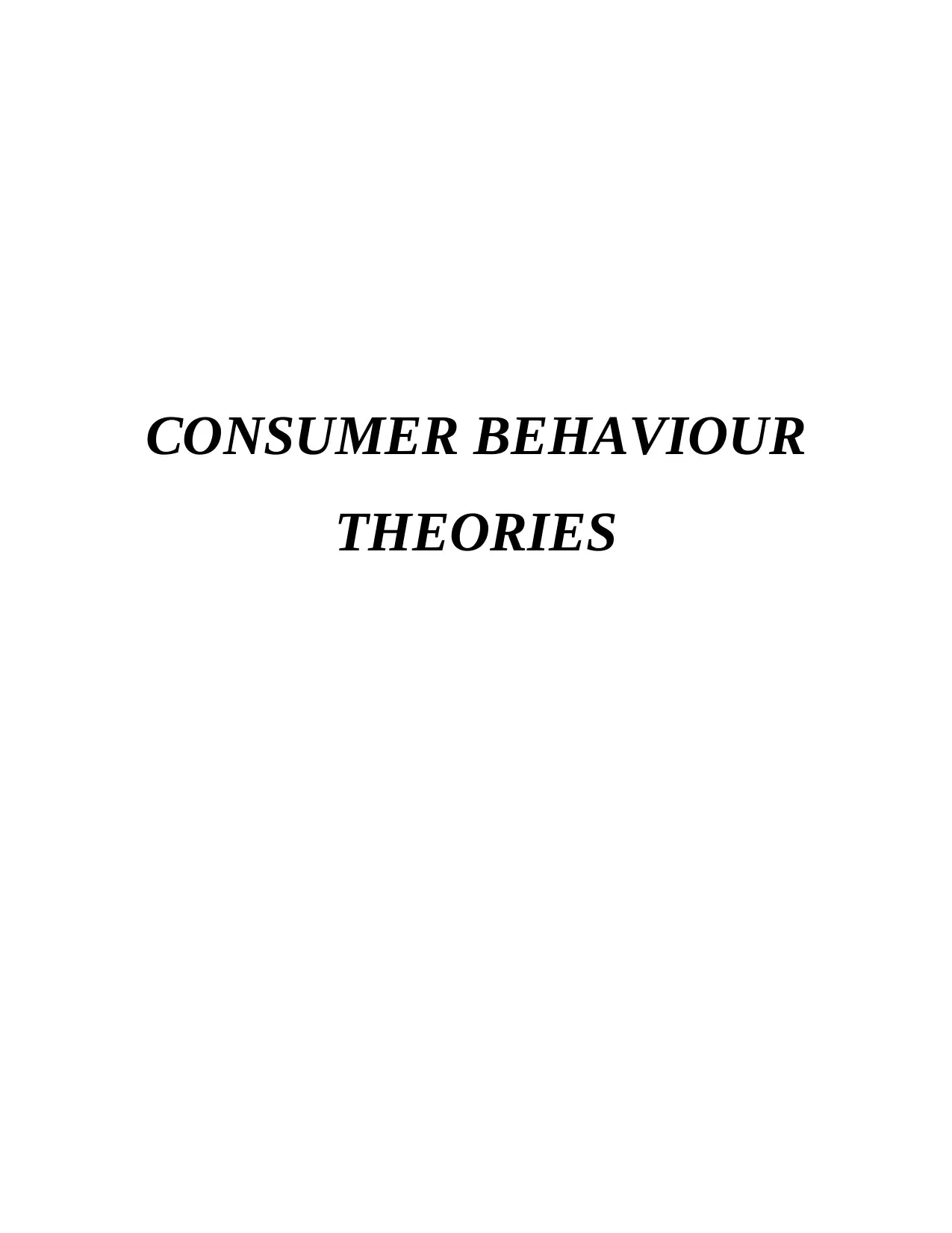
CONSUMER BEHAVIOUR
THEORIES
THEORIES
Paraphrase This Document
Need a fresh take? Get an instant paraphrase of this document with our AI Paraphraser
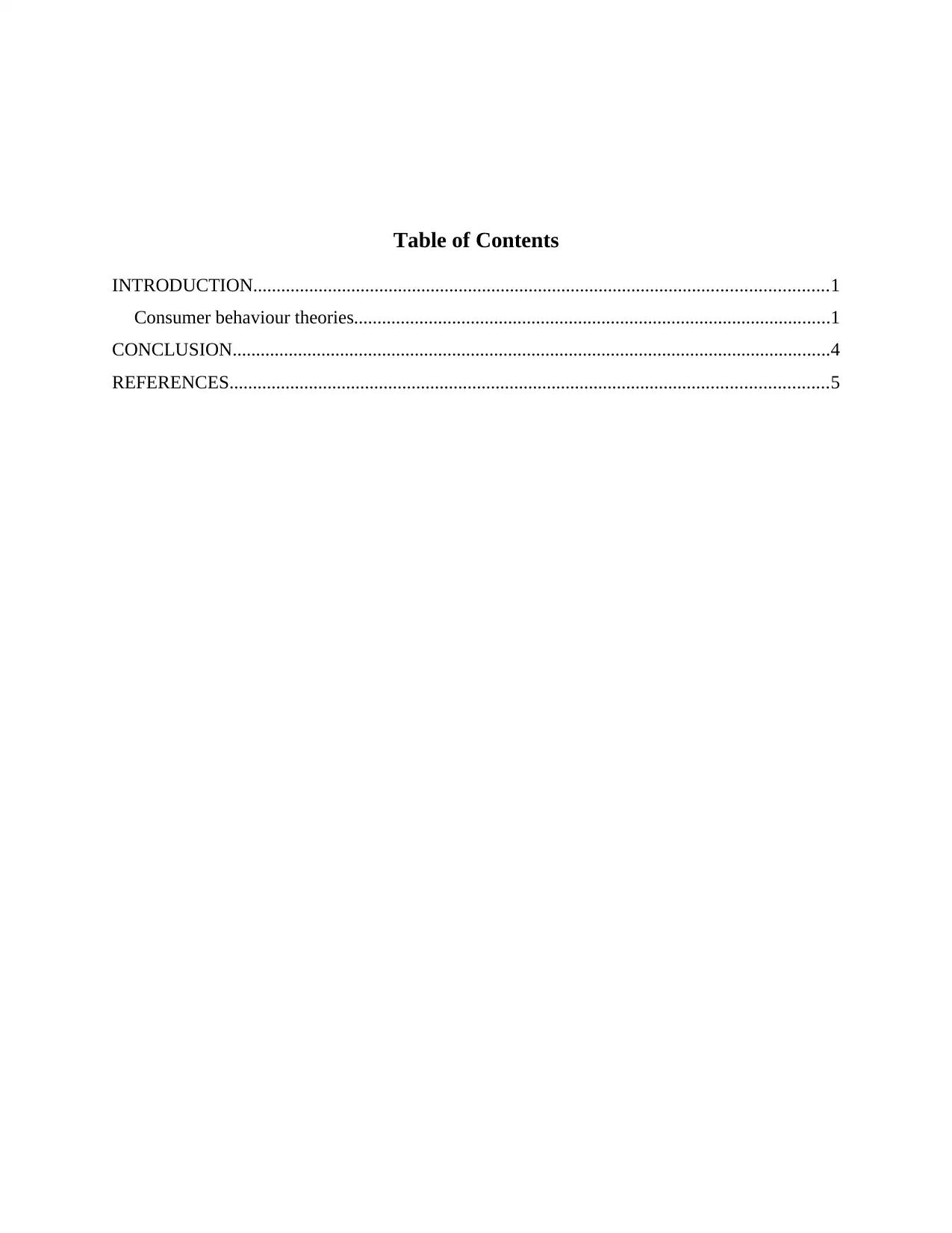
Table of Contents
INTRODUCTION...........................................................................................................................1
Consumer behaviour theories......................................................................................................1
CONCLUSION................................................................................................................................4
REFERENCES................................................................................................................................5
INTRODUCTION...........................................................................................................................1
Consumer behaviour theories......................................................................................................1
CONCLUSION................................................................................................................................4
REFERENCES................................................................................................................................5
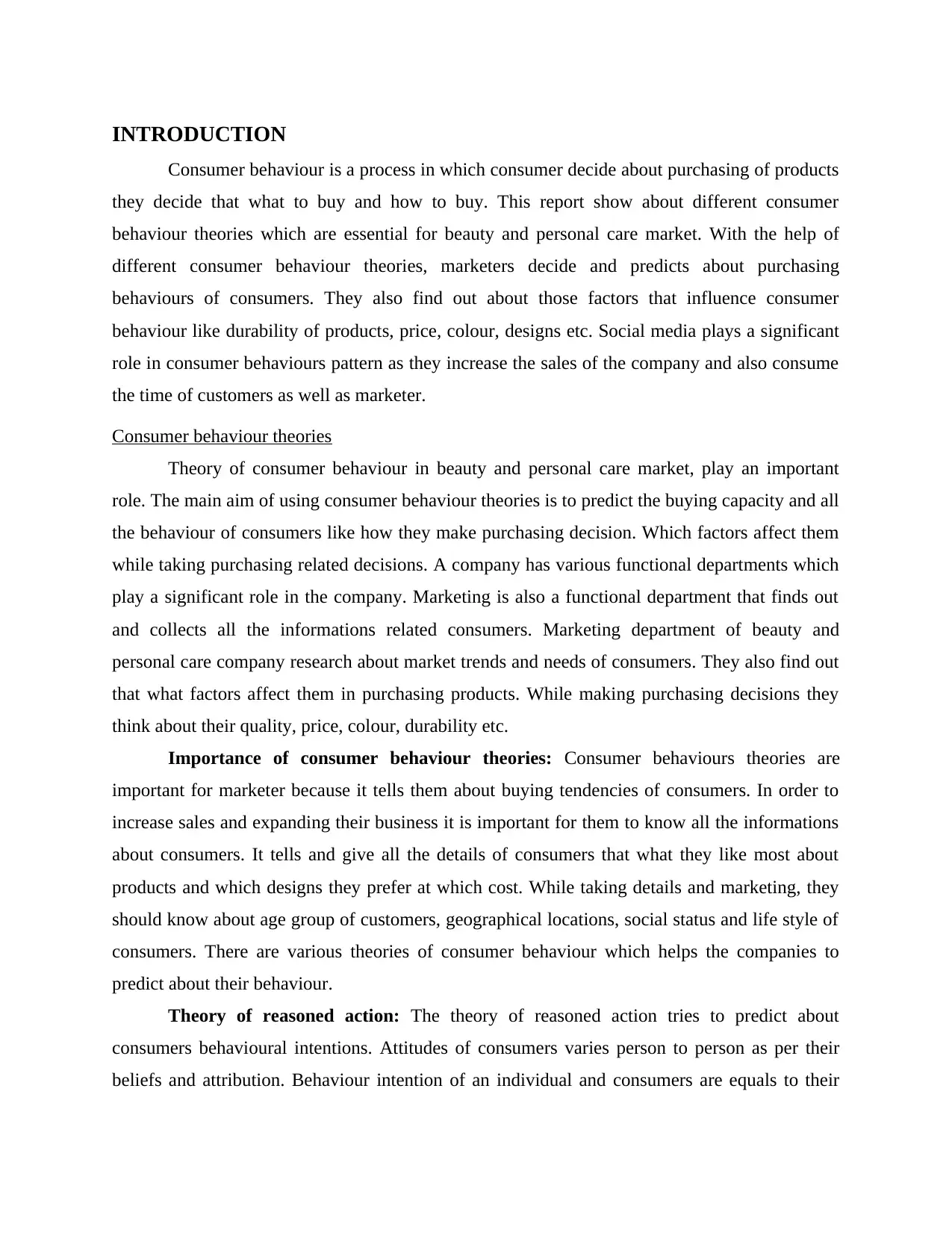
INTRODUCTION
Consumer behaviour is a process in which consumer decide about purchasing of products
they decide that what to buy and how to buy. This report show about different consumer
behaviour theories which are essential for beauty and personal care market. With the help of
different consumer behaviour theories, marketers decide and predicts about purchasing
behaviours of consumers. They also find out about those factors that influence consumer
behaviour like durability of products, price, colour, designs etc. Social media plays a significant
role in consumer behaviours pattern as they increase the sales of the company and also consume
the time of customers as well as marketer.
Consumer behaviour theories
Theory of consumer behaviour in beauty and personal care market, play an important
role. The main aim of using consumer behaviour theories is to predict the buying capacity and all
the behaviour of consumers like how they make purchasing decision. Which factors affect them
while taking purchasing related decisions. A company has various functional departments which
play a significant role in the company. Marketing is also a functional department that finds out
and collects all the informations related consumers. Marketing department of beauty and
personal care company research about market trends and needs of consumers. They also find out
that what factors affect them in purchasing products. While making purchasing decisions they
think about their quality, price, colour, durability etc.
Importance of consumer behaviour theories: Consumer behaviours theories are
important for marketer because it tells them about buying tendencies of consumers. In order to
increase sales and expanding their business it is important for them to know all the informations
about consumers. It tells and give all the details of consumers that what they like most about
products and which designs they prefer at which cost. While taking details and marketing, they
should know about age group of customers, geographical locations, social status and life style of
consumers. There are various theories of consumer behaviour which helps the companies to
predict about their behaviour.
Theory of reasoned action: The theory of reasoned action tries to predict about
consumers behavioural intentions. Attitudes of consumers varies person to person as per their
beliefs and attribution. Behaviour intention of an individual and consumers are equals to their
Consumer behaviour is a process in which consumer decide about purchasing of products
they decide that what to buy and how to buy. This report show about different consumer
behaviour theories which are essential for beauty and personal care market. With the help of
different consumer behaviour theories, marketers decide and predicts about purchasing
behaviours of consumers. They also find out about those factors that influence consumer
behaviour like durability of products, price, colour, designs etc. Social media plays a significant
role in consumer behaviours pattern as they increase the sales of the company and also consume
the time of customers as well as marketer.
Consumer behaviour theories
Theory of consumer behaviour in beauty and personal care market, play an important
role. The main aim of using consumer behaviour theories is to predict the buying capacity and all
the behaviour of consumers like how they make purchasing decision. Which factors affect them
while taking purchasing related decisions. A company has various functional departments which
play a significant role in the company. Marketing is also a functional department that finds out
and collects all the informations related consumers. Marketing department of beauty and
personal care company research about market trends and needs of consumers. They also find out
that what factors affect them in purchasing products. While making purchasing decisions they
think about their quality, price, colour, durability etc.
Importance of consumer behaviour theories: Consumer behaviours theories are
important for marketer because it tells them about buying tendencies of consumers. In order to
increase sales and expanding their business it is important for them to know all the informations
about consumers. It tells and give all the details of consumers that what they like most about
products and which designs they prefer at which cost. While taking details and marketing, they
should know about age group of customers, geographical locations, social status and life style of
consumers. There are various theories of consumer behaviour which helps the companies to
predict about their behaviour.
Theory of reasoned action: The theory of reasoned action tries to predict about
consumers behavioural intentions. Attitudes of consumers varies person to person as per their
beliefs and attribution. Behaviour intention of an individual and consumers are equals to their
⊘ This is a preview!⊘
Do you want full access?
Subscribe today to unlock all pages.

Trusted by 1+ million students worldwide
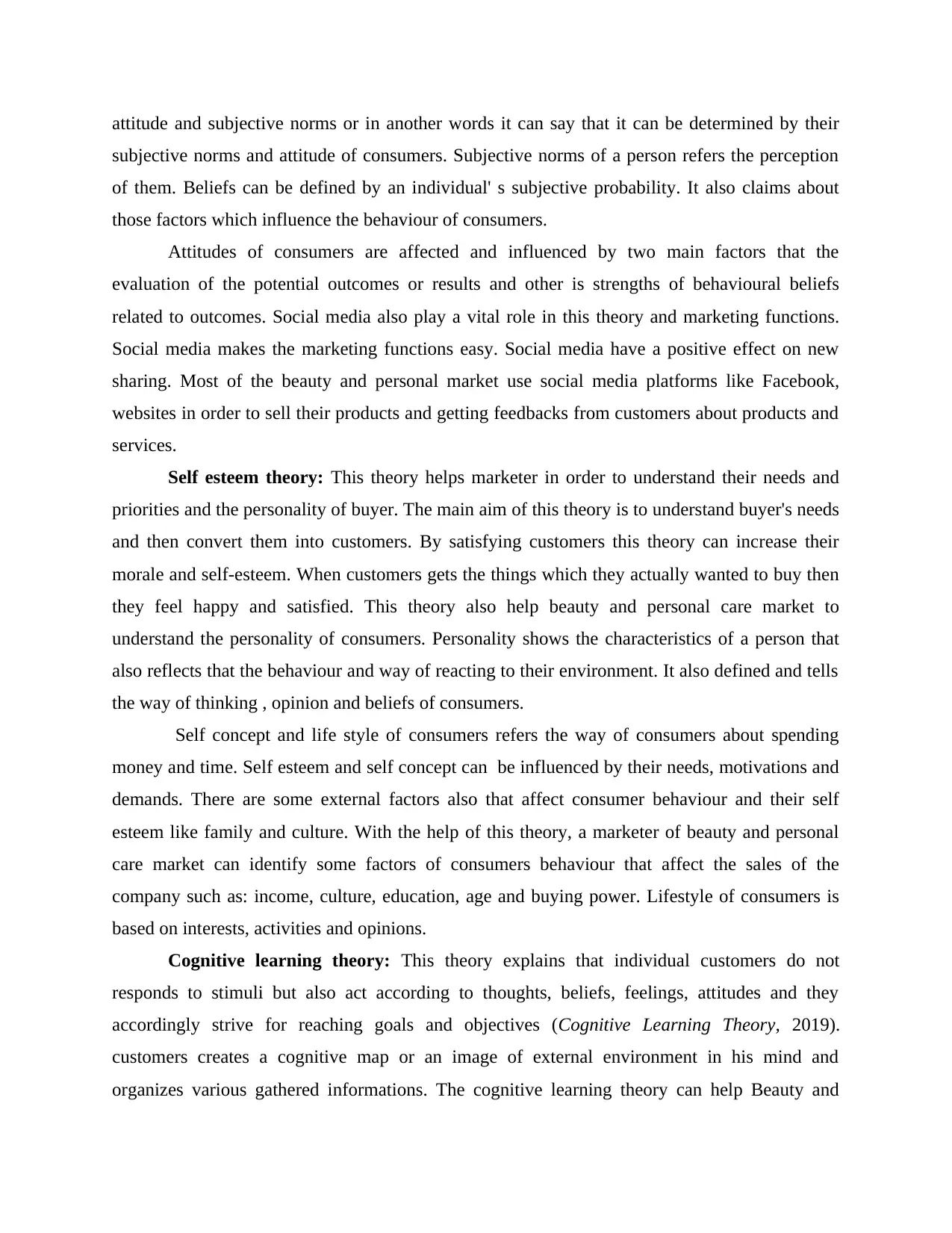
attitude and subjective norms or in another words it can say that it can be determined by their
subjective norms and attitude of consumers. Subjective norms of a person refers the perception
of them. Beliefs can be defined by an individual' s subjective probability. It also claims about
those factors which influence the behaviour of consumers.
Attitudes of consumers are affected and influenced by two main factors that the
evaluation of the potential outcomes or results and other is strengths of behavioural beliefs
related to outcomes. Social media also play a vital role in this theory and marketing functions.
Social media makes the marketing functions easy. Social media have a positive effect on new
sharing. Most of the beauty and personal market use social media platforms like Facebook,
websites in order to sell their products and getting feedbacks from customers about products and
services.
Self esteem theory: This theory helps marketer in order to understand their needs and
priorities and the personality of buyer. The main aim of this theory is to understand buyer's needs
and then convert them into customers. By satisfying customers this theory can increase their
morale and self-esteem. When customers gets the things which they actually wanted to buy then
they feel happy and satisfied. This theory also help beauty and personal care market to
understand the personality of consumers. Personality shows the characteristics of a person that
also reflects that the behaviour and way of reacting to their environment. It also defined and tells
the way of thinking , opinion and beliefs of consumers.
Self concept and life style of consumers refers the way of consumers about spending
money and time. Self esteem and self concept can be influenced by their needs, motivations and
demands. There are some external factors also that affect consumer behaviour and their self
esteem like family and culture. With the help of this theory, a marketer of beauty and personal
care market can identify some factors of consumers behaviour that affect the sales of the
company such as: income, culture, education, age and buying power. Lifestyle of consumers is
based on interests, activities and opinions.
Cognitive learning theory: This theory explains that individual customers do not
responds to stimuli but also act according to thoughts, beliefs, feelings, attitudes and they
accordingly strive for reaching goals and objectives (Cognitive Learning Theory, 2019).
customers creates a cognitive map or an image of external environment in his mind and
organizes various gathered informations. The cognitive learning theory can help Beauty and
subjective norms and attitude of consumers. Subjective norms of a person refers the perception
of them. Beliefs can be defined by an individual' s subjective probability. It also claims about
those factors which influence the behaviour of consumers.
Attitudes of consumers are affected and influenced by two main factors that the
evaluation of the potential outcomes or results and other is strengths of behavioural beliefs
related to outcomes. Social media also play a vital role in this theory and marketing functions.
Social media makes the marketing functions easy. Social media have a positive effect on new
sharing. Most of the beauty and personal market use social media platforms like Facebook,
websites in order to sell their products and getting feedbacks from customers about products and
services.
Self esteem theory: This theory helps marketer in order to understand their needs and
priorities and the personality of buyer. The main aim of this theory is to understand buyer's needs
and then convert them into customers. By satisfying customers this theory can increase their
morale and self-esteem. When customers gets the things which they actually wanted to buy then
they feel happy and satisfied. This theory also help beauty and personal care market to
understand the personality of consumers. Personality shows the characteristics of a person that
also reflects that the behaviour and way of reacting to their environment. It also defined and tells
the way of thinking , opinion and beliefs of consumers.
Self concept and life style of consumers refers the way of consumers about spending
money and time. Self esteem and self concept can be influenced by their needs, motivations and
demands. There are some external factors also that affect consumer behaviour and their self
esteem like family and culture. With the help of this theory, a marketer of beauty and personal
care market can identify some factors of consumers behaviour that affect the sales of the
company such as: income, culture, education, age and buying power. Lifestyle of consumers is
based on interests, activities and opinions.
Cognitive learning theory: This theory explains that individual customers do not
responds to stimuli but also act according to thoughts, beliefs, feelings, attitudes and they
accordingly strive for reaching goals and objectives (Cognitive Learning Theory, 2019).
customers creates a cognitive map or an image of external environment in his mind and
organizes various gathered informations. The cognitive learning theory can help Beauty and
Paraphrase This Document
Need a fresh take? Get an instant paraphrase of this document with our AI Paraphraser
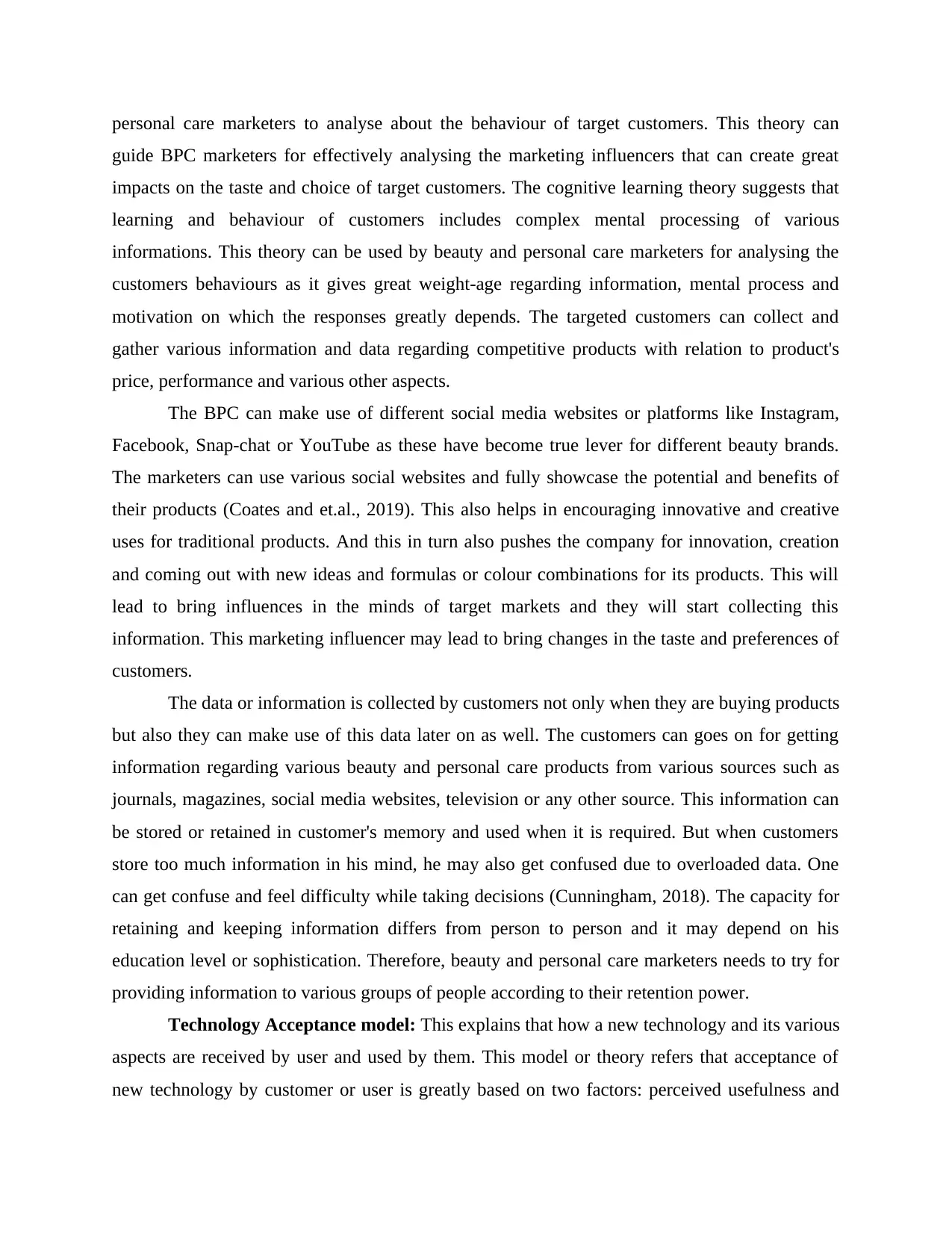
personal care marketers to analyse about the behaviour of target customers. This theory can
guide BPC marketers for effectively analysing the marketing influencers that can create great
impacts on the taste and choice of target customers. The cognitive learning theory suggests that
learning and behaviour of customers includes complex mental processing of various
informations. This theory can be used by beauty and personal care marketers for analysing the
customers behaviours as it gives great weight-age regarding information, mental process and
motivation on which the responses greatly depends. The targeted customers can collect and
gather various information and data regarding competitive products with relation to product's
price, performance and various other aspects.
The BPC can make use of different social media websites or platforms like Instagram,
Facebook, Snap-chat or YouTube as these have become true lever for different beauty brands.
The marketers can use various social websites and fully showcase the potential and benefits of
their products (Coates and et.al., 2019). This also helps in encouraging innovative and creative
uses for traditional products. And this in turn also pushes the company for innovation, creation
and coming out with new ideas and formulas or colour combinations for its products. This will
lead to bring influences in the minds of target markets and they will start collecting this
information. This marketing influencer may lead to bring changes in the taste and preferences of
customers.
The data or information is collected by customers not only when they are buying products
but also they can make use of this data later on as well. The customers can goes on for getting
information regarding various beauty and personal care products from various sources such as
journals, magazines, social media websites, television or any other source. This information can
be stored or retained in customer's memory and used when it is required. But when customers
store too much information in his mind, he may also get confused due to overloaded data. One
can get confuse and feel difficulty while taking decisions (Cunningham, 2018). The capacity for
retaining and keeping information differs from person to person and it may depend on his
education level or sophistication. Therefore, beauty and personal care marketers needs to try for
providing information to various groups of people according to their retention power.
Technology Acceptance model: This explains that how a new technology and its various
aspects are received by user and used by them. This model or theory refers that acceptance of
new technology by customer or user is greatly based on two factors: perceived usefulness and
guide BPC marketers for effectively analysing the marketing influencers that can create great
impacts on the taste and choice of target customers. The cognitive learning theory suggests that
learning and behaviour of customers includes complex mental processing of various
informations. This theory can be used by beauty and personal care marketers for analysing the
customers behaviours as it gives great weight-age regarding information, mental process and
motivation on which the responses greatly depends. The targeted customers can collect and
gather various information and data regarding competitive products with relation to product's
price, performance and various other aspects.
The BPC can make use of different social media websites or platforms like Instagram,
Facebook, Snap-chat or YouTube as these have become true lever for different beauty brands.
The marketers can use various social websites and fully showcase the potential and benefits of
their products (Coates and et.al., 2019). This also helps in encouraging innovative and creative
uses for traditional products. And this in turn also pushes the company for innovation, creation
and coming out with new ideas and formulas or colour combinations for its products. This will
lead to bring influences in the minds of target markets and they will start collecting this
information. This marketing influencer may lead to bring changes in the taste and preferences of
customers.
The data or information is collected by customers not only when they are buying products
but also they can make use of this data later on as well. The customers can goes on for getting
information regarding various beauty and personal care products from various sources such as
journals, magazines, social media websites, television or any other source. This information can
be stored or retained in customer's memory and used when it is required. But when customers
store too much information in his mind, he may also get confused due to overloaded data. One
can get confuse and feel difficulty while taking decisions (Cunningham, 2018). The capacity for
retaining and keeping information differs from person to person and it may depend on his
education level or sophistication. Therefore, beauty and personal care marketers needs to try for
providing information to various groups of people according to their retention power.
Technology Acceptance model: This explains that how a new technology and its various
aspects are received by user and used by them. This model or theory refers that acceptance of
new technology by customer or user is greatly based on two factors: perceived usefulness and
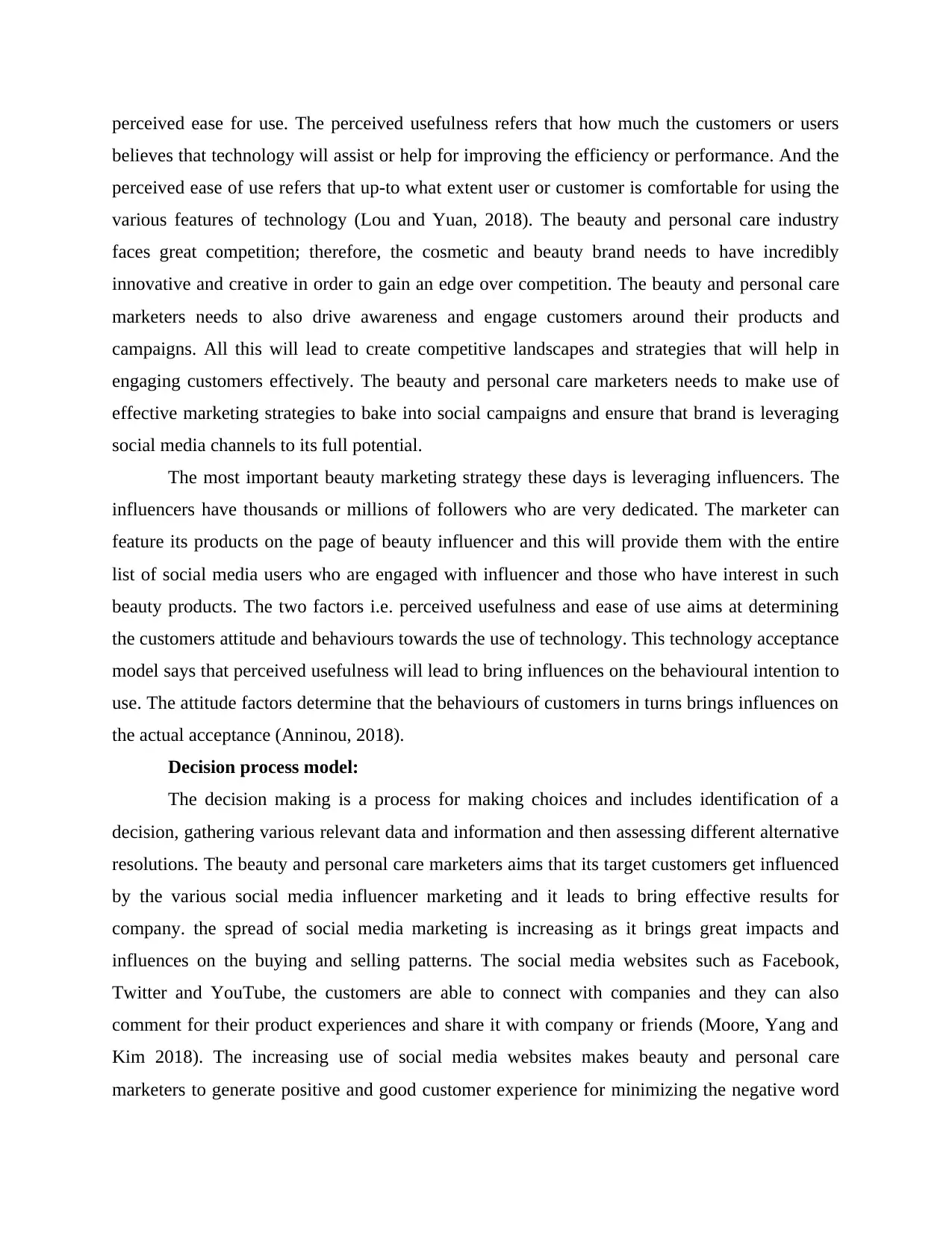
perceived ease for use. The perceived usefulness refers that how much the customers or users
believes that technology will assist or help for improving the efficiency or performance. And the
perceived ease of use refers that up-to what extent user or customer is comfortable for using the
various features of technology (Lou and Yuan, 2018). The beauty and personal care industry
faces great competition; therefore, the cosmetic and beauty brand needs to have incredibly
innovative and creative in order to gain an edge over competition. The beauty and personal care
marketers needs to also drive awareness and engage customers around their products and
campaigns. All this will lead to create competitive landscapes and strategies that will help in
engaging customers effectively. The beauty and personal care marketers needs to make use of
effective marketing strategies to bake into social campaigns and ensure that brand is leveraging
social media channels to its full potential.
The most important beauty marketing strategy these days is leveraging influencers. The
influencers have thousands or millions of followers who are very dedicated. The marketer can
feature its products on the page of beauty influencer and this will provide them with the entire
list of social media users who are engaged with influencer and those who have interest in such
beauty products. The two factors i.e. perceived usefulness and ease of use aims at determining
the customers attitude and behaviours towards the use of technology. This technology acceptance
model says that perceived usefulness will lead to bring influences on the behavioural intention to
use. The attitude factors determine that the behaviours of customers in turns brings influences on
the actual acceptance (Anninou, 2018).
Decision process model:
The decision making is a process for making choices and includes identification of a
decision, gathering various relevant data and information and then assessing different alternative
resolutions. The beauty and personal care marketers aims that its target customers get influenced
by the various social media influencer marketing and it leads to bring effective results for
company. the spread of social media marketing is increasing as it brings great impacts and
influences on the buying and selling patterns. The social media websites such as Facebook,
Twitter and YouTube, the customers are able to connect with companies and they can also
comment for their product experiences and share it with company or friends (Moore, Yang and
Kim 2018). The increasing use of social media websites makes beauty and personal care
marketers to generate positive and good customer experience for minimizing the negative word
believes that technology will assist or help for improving the efficiency or performance. And the
perceived ease of use refers that up-to what extent user or customer is comfortable for using the
various features of technology (Lou and Yuan, 2018). The beauty and personal care industry
faces great competition; therefore, the cosmetic and beauty brand needs to have incredibly
innovative and creative in order to gain an edge over competition. The beauty and personal care
marketers needs to also drive awareness and engage customers around their products and
campaigns. All this will lead to create competitive landscapes and strategies that will help in
engaging customers effectively. The beauty and personal care marketers needs to make use of
effective marketing strategies to bake into social campaigns and ensure that brand is leveraging
social media channels to its full potential.
The most important beauty marketing strategy these days is leveraging influencers. The
influencers have thousands or millions of followers who are very dedicated. The marketer can
feature its products on the page of beauty influencer and this will provide them with the entire
list of social media users who are engaged with influencer and those who have interest in such
beauty products. The two factors i.e. perceived usefulness and ease of use aims at determining
the customers attitude and behaviours towards the use of technology. This technology acceptance
model says that perceived usefulness will lead to bring influences on the behavioural intention to
use. The attitude factors determine that the behaviours of customers in turns brings influences on
the actual acceptance (Anninou, 2018).
Decision process model:
The decision making is a process for making choices and includes identification of a
decision, gathering various relevant data and information and then assessing different alternative
resolutions. The beauty and personal care marketers aims that its target customers get influenced
by the various social media influencer marketing and it leads to bring effective results for
company. the spread of social media marketing is increasing as it brings great impacts and
influences on the buying and selling patterns. The social media websites such as Facebook,
Twitter and YouTube, the customers are able to connect with companies and they can also
comment for their product experiences and share it with company or friends (Moore, Yang and
Kim 2018). The increasing use of social media websites makes beauty and personal care
marketers to generate positive and good customer experience for minimizing the negative word
⊘ This is a preview!⊘
Do you want full access?
Subscribe today to unlock all pages.

Trusted by 1+ million students worldwide
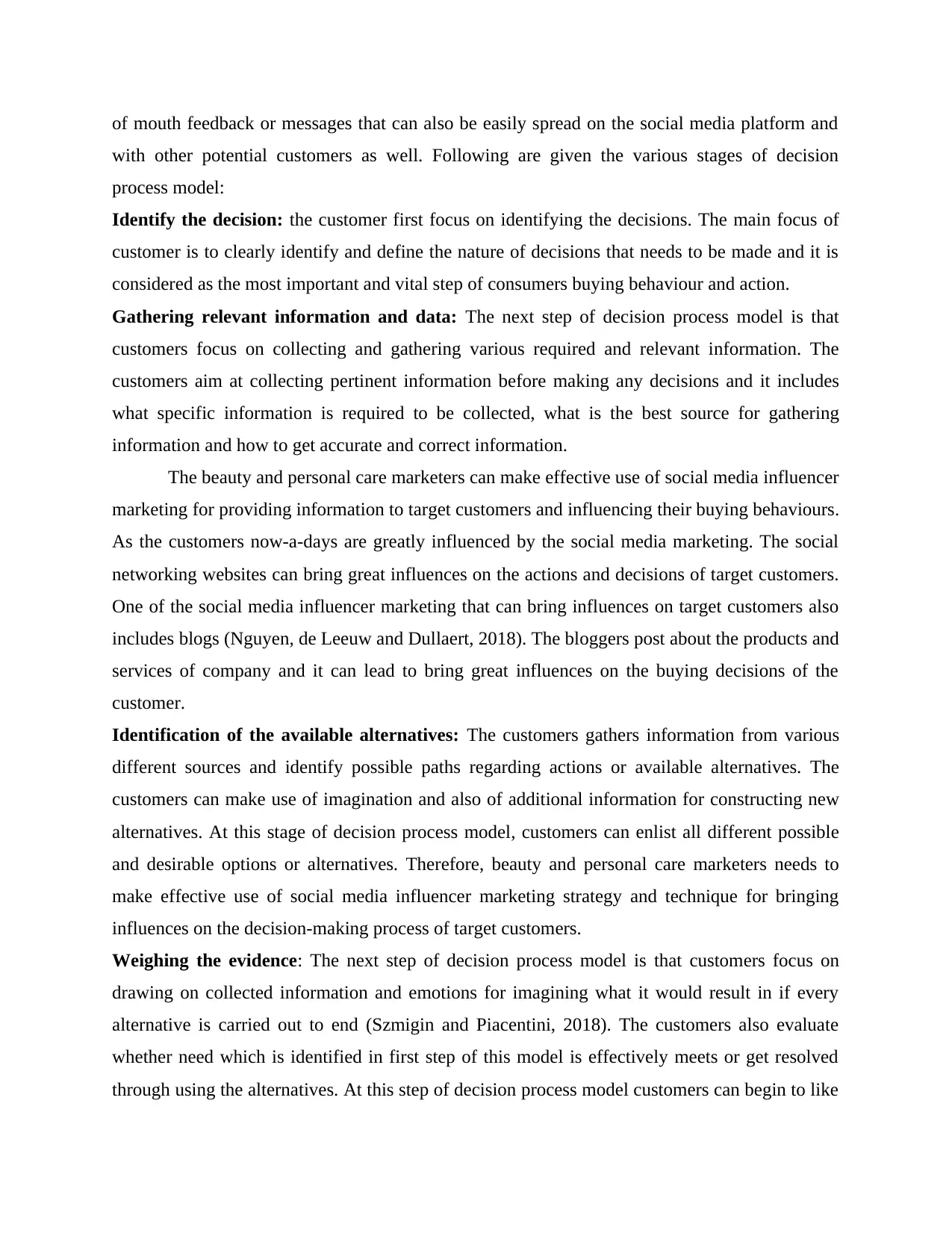
of mouth feedback or messages that can also be easily spread on the social media platform and
with other potential customers as well. Following are given the various stages of decision
process model:
Identify the decision: the customer first focus on identifying the decisions. The main focus of
customer is to clearly identify and define the nature of decisions that needs to be made and it is
considered as the most important and vital step of consumers buying behaviour and action.
Gathering relevant information and data: The next step of decision process model is that
customers focus on collecting and gathering various required and relevant information. The
customers aim at collecting pertinent information before making any decisions and it includes
what specific information is required to be collected, what is the best source for gathering
information and how to get accurate and correct information.
The beauty and personal care marketers can make effective use of social media influencer
marketing for providing information to target customers and influencing their buying behaviours.
As the customers now-a-days are greatly influenced by the social media marketing. The social
networking websites can bring great influences on the actions and decisions of target customers.
One of the social media influencer marketing that can bring influences on target customers also
includes blogs (Nguyen, de Leeuw and Dullaert, 2018). The bloggers post about the products and
services of company and it can lead to bring great influences on the buying decisions of the
customer.
Identification of the available alternatives: The customers gathers information from various
different sources and identify possible paths regarding actions or available alternatives. The
customers can make use of imagination and also of additional information for constructing new
alternatives. At this stage of decision process model, customers can enlist all different possible
and desirable options or alternatives. Therefore, beauty and personal care marketers needs to
make effective use of social media influencer marketing strategy and technique for bringing
influences on the decision-making process of target customers.
Weighing the evidence: The next step of decision process model is that customers focus on
drawing on collected information and emotions for imagining what it would result in if every
alternative is carried out to end (Szmigin and Piacentini, 2018). The customers also evaluate
whether need which is identified in first step of this model is effectively meets or get resolved
through using the alternatives. At this step of decision process model customers can begin to like
with other potential customers as well. Following are given the various stages of decision
process model:
Identify the decision: the customer first focus on identifying the decisions. The main focus of
customer is to clearly identify and define the nature of decisions that needs to be made and it is
considered as the most important and vital step of consumers buying behaviour and action.
Gathering relevant information and data: The next step of decision process model is that
customers focus on collecting and gathering various required and relevant information. The
customers aim at collecting pertinent information before making any decisions and it includes
what specific information is required to be collected, what is the best source for gathering
information and how to get accurate and correct information.
The beauty and personal care marketers can make effective use of social media influencer
marketing for providing information to target customers and influencing their buying behaviours.
As the customers now-a-days are greatly influenced by the social media marketing. The social
networking websites can bring great influences on the actions and decisions of target customers.
One of the social media influencer marketing that can bring influences on target customers also
includes blogs (Nguyen, de Leeuw and Dullaert, 2018). The bloggers post about the products and
services of company and it can lead to bring great influences on the buying decisions of the
customer.
Identification of the available alternatives: The customers gathers information from various
different sources and identify possible paths regarding actions or available alternatives. The
customers can make use of imagination and also of additional information for constructing new
alternatives. At this stage of decision process model, customers can enlist all different possible
and desirable options or alternatives. Therefore, beauty and personal care marketers needs to
make effective use of social media influencer marketing strategy and technique for bringing
influences on the decision-making process of target customers.
Weighing the evidence: The next step of decision process model is that customers focus on
drawing on collected information and emotions for imagining what it would result in if every
alternative is carried out to end (Szmigin and Piacentini, 2018). The customers also evaluate
whether need which is identified in first step of this model is effectively meets or get resolved
through using the alternatives. At this step of decision process model customers can begin to like
Paraphrase This Document
Need a fresh take? Get an instant paraphrase of this document with our AI Paraphraser
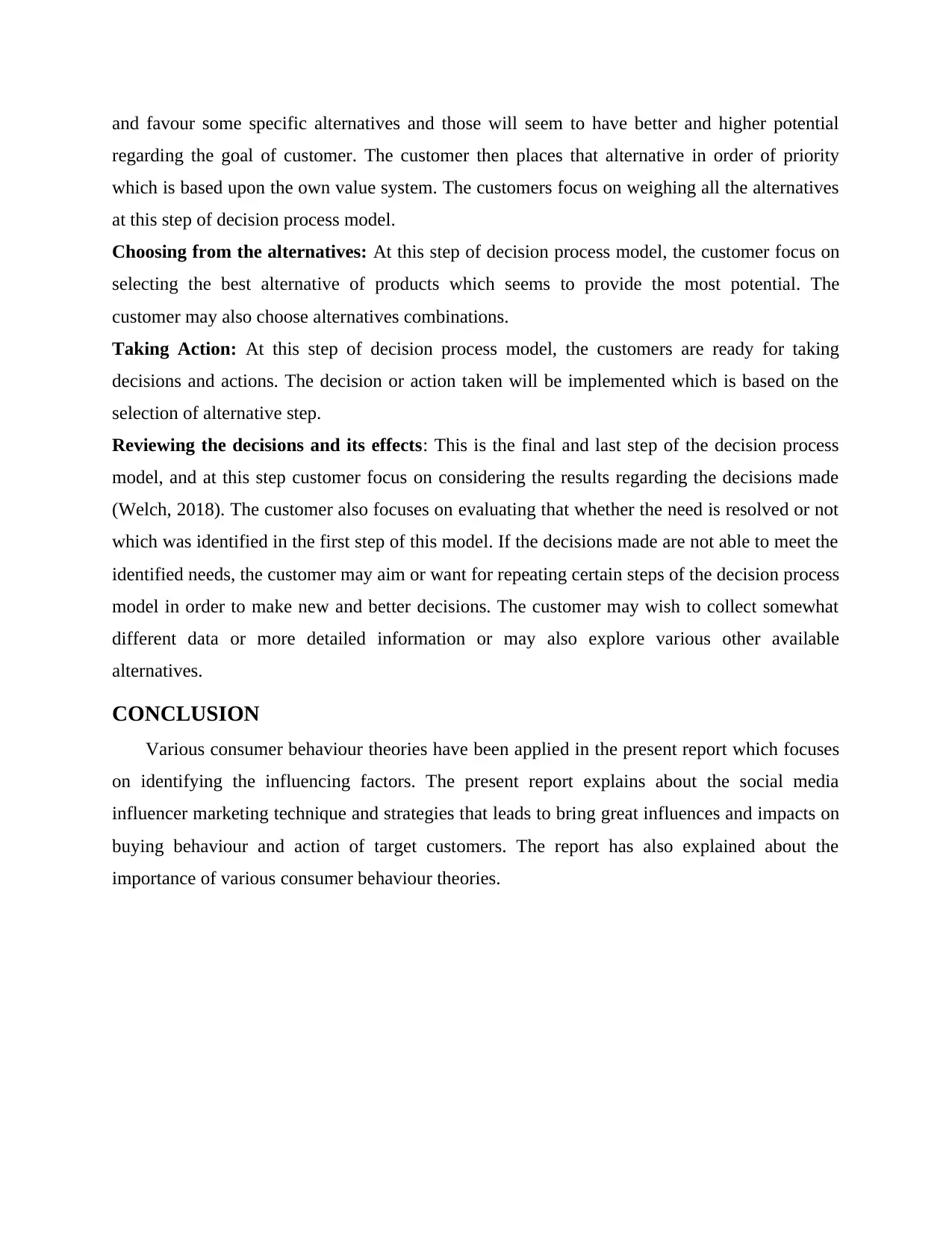
and favour some specific alternatives and those will seem to have better and higher potential
regarding the goal of customer. The customer then places that alternative in order of priority
which is based upon the own value system. The customers focus on weighing all the alternatives
at this step of decision process model.
Choosing from the alternatives: At this step of decision process model, the customer focus on
selecting the best alternative of products which seems to provide the most potential. The
customer may also choose alternatives combinations.
Taking Action: At this step of decision process model, the customers are ready for taking
decisions and actions. The decision or action taken will be implemented which is based on the
selection of alternative step.
Reviewing the decisions and its effects: This is the final and last step of the decision process
model, and at this step customer focus on considering the results regarding the decisions made
(Welch, 2018). The customer also focuses on evaluating that whether the need is resolved or not
which was identified in the first step of this model. If the decisions made are not able to meet the
identified needs, the customer may aim or want for repeating certain steps of the decision process
model in order to make new and better decisions. The customer may wish to collect somewhat
different data or more detailed information or may also explore various other available
alternatives.
CONCLUSION
Various consumer behaviour theories have been applied in the present report which focuses
on identifying the influencing factors. The present report explains about the social media
influencer marketing technique and strategies that leads to bring great influences and impacts on
buying behaviour and action of target customers. The report has also explained about the
importance of various consumer behaviour theories.
regarding the goal of customer. The customer then places that alternative in order of priority
which is based upon the own value system. The customers focus on weighing all the alternatives
at this step of decision process model.
Choosing from the alternatives: At this step of decision process model, the customer focus on
selecting the best alternative of products which seems to provide the most potential. The
customer may also choose alternatives combinations.
Taking Action: At this step of decision process model, the customers are ready for taking
decisions and actions. The decision or action taken will be implemented which is based on the
selection of alternative step.
Reviewing the decisions and its effects: This is the final and last step of the decision process
model, and at this step customer focus on considering the results regarding the decisions made
(Welch, 2018). The customer also focuses on evaluating that whether the need is resolved or not
which was identified in the first step of this model. If the decisions made are not able to meet the
identified needs, the customer may aim or want for repeating certain steps of the decision process
model in order to make new and better decisions. The customer may wish to collect somewhat
different data or more detailed information or may also explore various other available
alternatives.
CONCLUSION
Various consumer behaviour theories have been applied in the present report which focuses
on identifying the influencing factors. The present report explains about the social media
influencer marketing technique and strategies that leads to bring great influences and impacts on
buying behaviour and action of target customers. The report has also explained about the
importance of various consumer behaviour theories.
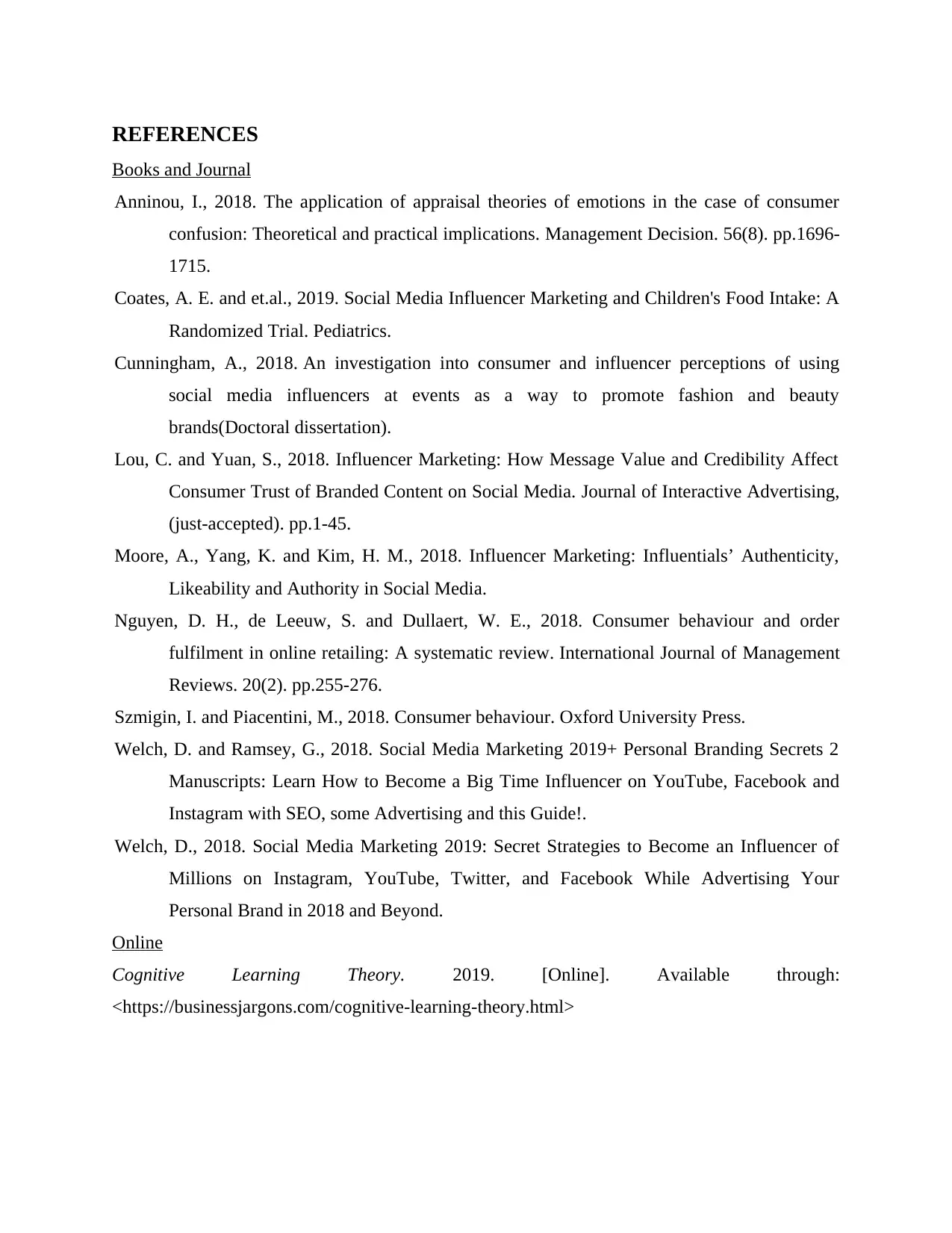
REFERENCES
Books and Journal
Anninou, I., 2018. The application of appraisal theories of emotions in the case of consumer
confusion: Theoretical and practical implications. Management Decision. 56(8). pp.1696-
1715.
Coates, A. E. and et.al., 2019. Social Media Influencer Marketing and Children's Food Intake: A
Randomized Trial. Pediatrics.
Cunningham, A., 2018. An investigation into consumer and influencer perceptions of using
social media influencers at events as a way to promote fashion and beauty
brands(Doctoral dissertation).
Lou, C. and Yuan, S., 2018. Influencer Marketing: How Message Value and Credibility Affect
Consumer Trust of Branded Content on Social Media. Journal of Interactive Advertising,
(just-accepted). pp.1-45.
Moore, A., Yang, K. and Kim, H. M., 2018. Influencer Marketing: Influentials’ Authenticity,
Likeability and Authority in Social Media.
Nguyen, D. H., de Leeuw, S. and Dullaert, W. E., 2018. Consumer behaviour and order
fulfilment in online retailing: A systematic review. International Journal of Management
Reviews. 20(2). pp.255-276.
Szmigin, I. and Piacentini, M., 2018. Consumer behaviour. Oxford University Press.
Welch, D. and Ramsey, G., 2018. Social Media Marketing 2019+ Personal Branding Secrets 2
Manuscripts: Learn How to Become a Big Time Influencer on YouTube, Facebook and
Instagram with SEO, some Advertising and this Guide!.
Welch, D., 2018. Social Media Marketing 2019: Secret Strategies to Become an Influencer of
Millions on Instagram, YouTube, Twitter, and Facebook While Advertising Your
Personal Brand in 2018 and Beyond.
Online
Cognitive Learning Theory. 2019. [Online]. Available through:
<https://businessjargons.com/cognitive-learning-theory.html>
Books and Journal
Anninou, I., 2018. The application of appraisal theories of emotions in the case of consumer
confusion: Theoretical and practical implications. Management Decision. 56(8). pp.1696-
1715.
Coates, A. E. and et.al., 2019. Social Media Influencer Marketing and Children's Food Intake: A
Randomized Trial. Pediatrics.
Cunningham, A., 2018. An investigation into consumer and influencer perceptions of using
social media influencers at events as a way to promote fashion and beauty
brands(Doctoral dissertation).
Lou, C. and Yuan, S., 2018. Influencer Marketing: How Message Value and Credibility Affect
Consumer Trust of Branded Content on Social Media. Journal of Interactive Advertising,
(just-accepted). pp.1-45.
Moore, A., Yang, K. and Kim, H. M., 2018. Influencer Marketing: Influentials’ Authenticity,
Likeability and Authority in Social Media.
Nguyen, D. H., de Leeuw, S. and Dullaert, W. E., 2018. Consumer behaviour and order
fulfilment in online retailing: A systematic review. International Journal of Management
Reviews. 20(2). pp.255-276.
Szmigin, I. and Piacentini, M., 2018. Consumer behaviour. Oxford University Press.
Welch, D. and Ramsey, G., 2018. Social Media Marketing 2019+ Personal Branding Secrets 2
Manuscripts: Learn How to Become a Big Time Influencer on YouTube, Facebook and
Instagram with SEO, some Advertising and this Guide!.
Welch, D., 2018. Social Media Marketing 2019: Secret Strategies to Become an Influencer of
Millions on Instagram, YouTube, Twitter, and Facebook While Advertising Your
Personal Brand in 2018 and Beyond.
Online
Cognitive Learning Theory. 2019. [Online]. Available through:
<https://businessjargons.com/cognitive-learning-theory.html>
⊘ This is a preview!⊘
Do you want full access?
Subscribe today to unlock all pages.

Trusted by 1+ million students worldwide
1 out of 9
Related Documents
Your All-in-One AI-Powered Toolkit for Academic Success.
+13062052269
info@desklib.com
Available 24*7 on WhatsApp / Email
![[object Object]](/_next/static/media/star-bottom.7253800d.svg)
Unlock your academic potential
Copyright © 2020–2025 A2Z Services. All Rights Reserved. Developed and managed by ZUCOL.




